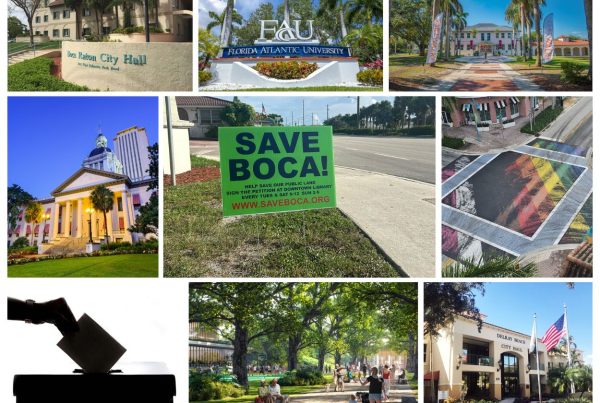
The Mark: Whose fault was it?
A whodunit played out last Thursday in the Boca Raton Community Center, except that the subject wasn’t a body— it was a building.
That building is the Mark at Cityscape, the mixed-use project near the intersection of Federal Highway and Palmetto Park Road. It is the first project Boca Raton approved under the city’s Interim Design Guidelines, which were crafted with the goal of producing distinctive, stylish structures that set the city’s downtown apart.
But as construction of the Mark neared completion—the developer, Ram Realty, just got the certificate of occupancy —residents and city council members began to complain that the Mark looked no better than structures approved under the old guidelines. Plus, the new guidelines allowed Ram more height in exchange for supposedly producing a project that is pleasing to the eye. Where was the public benefit?
So the city’s consultant, Urban Design Associates, scheduled last Thursday’s daylong meeting to pick over the Mark and, in so doing, pick over the new guidelines. Mayor Susan Haynie, who was there as a spectator, summed up the general public sentiment when she told me, “If (the Mark) is what we get from the guidelines, there’s something wrong.”
Haynie has a particular interest in the review, since she voted to approve the Mark. The other council holdover who voted for the project is Mike Mullaugh.
Eric Osth of Urban Design Associates led the discussion. In language that often was aimed more at professionals than the public—“redevelopment paradigms”—Osth spoke of how his firm had created for Boca Raton a Pattern Book that would guide developers and create a skyline in the best tradition of Addison Mizner. Listening to this discussion of the test project for a better downtown, were, among others, city staffers, members of the Downtown Advisory Committee and architects.
Then Osth began to critique the Mark. He said the walkways aren’t pedestrian-friendly. One lamppost is in the middle of a sidewalk. The building’s façade could look better in places. More variation in paint color would make the building look more inviting. Tinted glass in the ground-floor retail space will make people keep walking, rather than stop and look.
Yet when the project came before the city council—acting as the Community Redevelopment Agency—on May 21, 2012, the backup material contained a letter to Susan Lesser, a senior planner for the city, from Osth. In the letter, Osth said his firm had reviewed the application and offered some suggestions. Yet the firm’s recommendation was to approve what then was called the Palmetto Park Mixed Use Building. Osth called it “a beautifully designed building and a positive addition to Downtown Boca Raton.”
Council members also saw a 5-0 vote for approval by the Planning & Zoning Board. They saw a 6-0 vote for approval by the Community Appearance Board, which is supposed to review the sorts of items Osth considers problems with the Mark. Council members saw a recommendation for approval from City Manager Leif Ahnell, based in part on the Development Services Department’s review of the project. It was the second version of the project, which is part of the roughly 9.5-acre site that also will include the Hyatt Place Hotel.
Most of the discussion three years ago focused on the fact that the 208 residential units would be rentals. Council members asked whether the units would be upscale enough to fit Boca’s image. Like the UDA consultants, Haynie saw the project as helpful in accomplishing the city’s long-held goal of connecting Mizner Park and Royal Palm Place. Anthony Majhess, the only dissenting vote, said the project didn’t meet UDA’s guidelines, despite the consultant’s support. Majhess did express hope that the project would be complete before final adoption of the Pattern Book, so the city could make any changes. The Pattern Book, like the guidelines, has not been adopted.
The most interested participant at Thursday’s meeting was Juan Caycedo, of RLC Architects. Caycedo designed the Mark, and had to sit while other participants performed an autopsy on a building that hasn’t opened.
In an interview Monday, Caycedo defended his design by saying that the critical judgments are premature. “People make places,” he said. “Once you have activity, it will bring life.” When people and business arrive, Boca residents will see “a better pedestrian space.”
Caycedo also revealed that some of what UDA’s Osth criticized were not his decisions. The developers chose the outside colors. Caycedo proposed clear glass for the first floor. The developers went with tinted glass. Osth also told me that he still considers the Mark a “beautifully designed building,” but that “there a lot of elements on the implementation side.”
Thursday’s discussion identified no single perp in this downtown development whodunit. Still, if the Mark went all through this new process with new guidelines and has surprised in the wrong way, there at least is what Haynie called “disconnect” among the consultants—“UDA talked us into this contract,” Haynie said—city planners, advisory board members and architects. Osth did offer an idea that would seem automatic: regular, early meetings between architects and city planners after approval of a project. “Standard procedure in all cities,” Osth said. Caycedo likes the idea. Why hasn’t Boca Raton been doing that all along?
Yet to be completed are two other projects approved under the new guidelines: Via Mizner at Camino Real and Federal Highway and the Hyatt Place Hotel, which drew much early praise last fall. Boca Raton will wait anxiously to see the finished products, because, as Haynie said, “If (the Mark) is a test case” of the Interim Design Guidelines and Pattern Book, “we miserably failed.”
Clarification
In my post for last Thursday, I might have given readers the impression that Boca Raton approved the Palmetto Promenade project – once known as Archstone – under the Interim Design Guidelines. The city adopted them in 2008 as Ordinance 5052. To be clear, the city approved Palmetto Promenade under the old guidelines, which the city adopted in 1992 as Ordinance 4035.
Trash rebate?
Apparently, not only will Delray Beach save money on the new trash-hauling contract when it begins June 1, some residents will get a refund.
According to City Manager Don Cooper, Delray Beach collected about $1.7 million in excessive fees from 1997 to 2013 for carts used in residential curbside pickup. Cooper recommends keeping $900,000 for contingency, in case the carts must be replaced. The rest would go back to residential curbside customers. The city commission takes a first vote on the issue tonight.
A bold idea: Braves at FAU
One important local bill that did get through the Florida Legislature despite the House quitting early last week would allow work to proceed on a second spring training stadium in Palm Beach County. The complex in West Palm Beach, scheduled to open in 2017, will be home to the Houston Astros and Washington Nationals, as Roger Dean Stadium in Jupiter is home to the Miami Marlins and the St. Louis Cardinals.
The bill is technical; it changes the boundaries of the West Palm Beach Water Catchment Area so construction can start on schedule. The county is negotiating with the Marlins and Cardinals on stadium improvements that would keep the teams—and especially the many Cardinals fans who visit—at Roger Dean through 2045, roughly the lease period for the teams in West Palm Beach.
When news of the new stadium deal broke, The Palm Beach Post reported, the Atlanta Braves expressed interest in bringing spring training operations back to the county. The Braves trained at West Palm Beach Municipal Stadium —since demolished—from 1962 until 1997. The Braves bolted for a better deal at Disney World, showing why governments in Florida seek long leases.
The chances of the Braves returning are low, for many reasons. But there is one place in Palm Beach County with an existing stadium—Florida Atlantic University. The stadium seats only about 2,000 and would need more seats and other major upgrades. The Braves also would need a minor-league complex.
That second stadium will take a large portion of the tourist tax revenue that finances projects whose goal is to draw visitors, but since FAU President John Kelly quickly has become known for thinking big, wouldn’t he at least want to ask, say, the county sports commission if FAU might have a role in going after the Braves?
South Florida less racist
Baltimore has become the latest city to face a gut check on the conditions of its poor, black residents. The examination won’t be any easier just because the mayor and police chief are African-American.
With race on people’s minds, it may cheer you to know that based on a recently released study, South Florida is less racist on average than other parts of the country. Researcher Seth Stephens-Davidowitz based his research on a study of how often residents in the nation’s media markets use Google to search for the “N-word.” The rates were highest in parts of the Deep South—no surprise there —and through the Appalachians into New England.
How credible is such research? Perhaps more than you might think. According to the Washington Post, Stephens-Davidowitz’s findings align fairly well with results from a study of racist Tweets by researchers at Humboldt State (Calif.) University.
Stephens-Davidowitz put the country’s media markets into four groups, where he found that there was 1) much more racism than average, 2) more racism than average, 3) less racism than average and 4) much less racism than average. Palm Beach, Broward and Dade counties came in as less average.
••••••••
You can email Randy Schultz at randy@bocamag.com
For more City Watch blogs, click here.About the Author
Randy Schultz was born in Hartford, Conn., and graduated from the University of Tennessee in 1974. He has lived in South Florida since then, and in Boca Raton since 1985. Schultz spent nearly 40 years in daily journalism at the Miami Herald and Palm Beach Post, most recently as editorial page editor at the Post. His wife, Shelley, is director of The Learning Network at Pine Crest School. His son, an attorney, and daughter-in-law and three grandchildren also live in Boca Raton. His daughter is a veterinarian who lives in Baltimore.







